Related Research Articles

Mummy portraits or Fayum mummy portraits are a type of naturalistic painted portrait on wooden boards attached to upper class mummies from Roman Egypt. They belong to the tradition of panel painting, one of the most highly regarded forms of art in the Classical world. The Fayum portraits are the only large body of art from that tradition to have survived. They were formerly, and incorrectly, called Coptic portraits.

Elaine Marie Catherine de Kooning was an Abstract Expressionist and Figurative Expressionist painter in the post-World War II era. She wrote extensively on the art of the period and was an editorial associate for Art News magazine.
Jenny Sages is an Archibald Prize People's Choice Award winning Australian artist born 1933 in Shanghai, China. She is known for her abstract landscape paintings and portraits. She arrived in Australia in 1948. After being expelled from East Sydney Tech, Jenny moved to New York to study at Franklin School of Art. She was a freelance writer and illustrator for Vogue Australia until the 1980s before starting full-time painting in 1985 at the age of 52. Her career transformation was greatly influenced by a trip to Kimberley, Western Australia, where she felt enchanted by the local indigenous culture. Her unique style is created using wax and pigments and the minimal use of brushes.

The School of Athens is a fresco by the Italian Renaissance artist Raphael. The fresco was painted between 1509 and 1511 as a part of Raphael's commission to decorate the rooms now known as the Stanze di Raffaello, in the Apostolic Palace in the Vatican. It depicts a congregation of philosophers, mathematicians, and scientists from Ancient Greece, including Plato, Aristotle, Pythagoras, Archimedes, and Heraclitus. The Italian artists Leonardo da Vinci and Michelangelo are also featured in the painting, shown as Plato and Heraclitus respectively.

Faiyum is a city in Middle Egypt. Located 100 kilometres southwest of Cairo, in the Faiyum Oasis, it is the capital of the modern Faiyum Governorate. Originally called Shedet in Egyptian, the Greeks called it in Koinē Greek: Κροκοδειλόπολις, romanized: Krokodilópolis, and later Medieval Greek: Ἀρσινόη, romanized: Arsinoë. It is one of Egypt's oldest cities due to its strategic location.
Ianna Andreadis is a Greek-origin artist and photographer who has created many books, published in France and Mexico, as well as international projects with worldwide participation. In 2004, she coordinated a digital photo project called The World Around a Flame/Olympic Truce 2004 that was exhibited in Athens during the Olympic Games that year. She is based in France.

The Severan Tondo or Berlin Tondo from circa 200 AD, is one of the few preserved examples of panel painting from Classical Antiquity, depicting the first two generations of the imperial Severan dynasty, whose members ruled the Roman Empire in the late 2nd and early 3rd centuries. It depicts the Roman emperor Septimius Severus with his wife, the augusta Julia Domna, and their two sons and co-augusti Caracalla and Geta. The face of one of the two brothers has been deliberately erased, very likely as part of damnatio memoriae.

Coptic art is the Christian art of the Byzantine-Greco-Roman Egypt and of Coptic Christian Churches. Coptic art is best known for its wall-paintings, textiles, illuminated manuscripts, and metalwork, much of which survives in monasteries and churches. The artwork is often functional, as little distinction was drawn between artistry and craftsmanship, and includes tunics and tombstones as well as portraits of saints. The Coptic Museum in Coptic Cairo houses some of the world's most important examples of Coptic art.
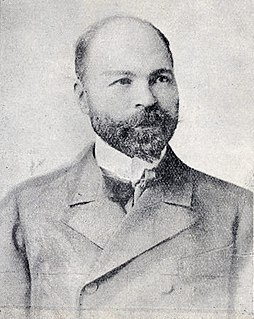
Georgios Jakobides was a painter and one of the main representatives of the Greek artistic movement of the Munich School. He founded and was the first curator of the National Gallery of Greece in Athens.
The following outline is provided as an overview of and topical guide to the history of painting:
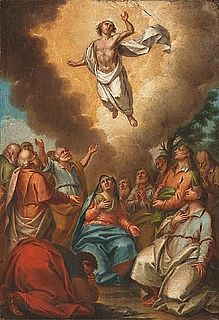
The Heptanese School of painting succeeded the Cretan School as the leading school of Greek post-Byzantine painting after Crete fell to the Ottomans in 1669. Like the Cretan school, it combined Byzantine traditions with an increasing Western European artistic influence and also saw the first significant depiction of secular subjects. The school was based in the Ionian Islands, which were not part of Ottoman Greece, from the middle of the 17th century until the middle of the 19th century. The center of Greek art migrated urgently to the Ionian islands but countless Greek artists were influenced by the school including the ones living throughout the Greek communities in the Ottoman Empire and elsewhere in the world.

Panagiotis Doxaras (1662–1729) also known as Panayiotis Doxaras, was an author and painter. He was a prolific member of the Heptanese School. He was influenced by early members of the movement namely: Elias Moskos, Theodoros Poulakis, Stephanos Tzangarolas, Spyridon Sperantzas and Victor. The Heptanese School evolved during the Baroque period and continued into the Late Baroque or Rococo. Doxaras’s son Nikolaos Doxaras continued the artistic movement into the Neoclassical era. Both Panagiotis and his son Nikolaos Doxaras refined the school. The school was heavily influenced by the Venetian Style. The Heptanese School also influenced Italian painting. Other artists Doxaras influenced were Nikolaos Kantounis. Panagioti’s teacher was famous painter Leos Moskos. He studied with him while he was in Venice. Doxaras painted notable portraits of Johann Matthias von der Schulenburg. He introduced Maniera Italiana to the Heptanese School drastically changing the style from the Maniera Greca. He is considered the father of the Greek Rococo and the Modern Greek Enlightenment in art.

The Paul and Alexandra Canellopoulos Museum is a museum of antiquities in Athens, Greece. It is situated in the north slope of Acropolis, in the district of Plaka. Founded in 1976, it houses the collection of Paul and Alexandra Canellopoulos, which started being formed in 1923 and was donated to the Greek state in 1972. The collection features ca. 6500 items of Prehistoric, Ancient Greek, Byzantine and post-Byzantine art, spanning almost six millennia of history.

Severan art is art production by the Roman Empire under the Severan dynasty, usually taken as running from 193 to 235, through the emperors Septimius Severus, Caracalla, Heliogabalus and Alexander Severus. Official Roman art of the military anarchy which followed, ending in 253 with Gallienus, has no character of its own and so can be seen as a continuation of Severan art, and so that art can be seen as running for the whole first half of the 3rd century.
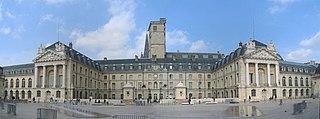
The Musée des Beaux-Arts de Dijon is a museum of fine arts opened in 1787 in Dijon, France. It is one of the main and oldest museums of France. It is located in the historic city centre of Dijon and housed in the former ducal palace which was the headquarters of the Burgundy State in the 15th century. When the duchy was assimilated to the Kingdom of France, the palace became the house of the King. In the 17th century it became the Palace of the Dukes of Burgundy following a project by Jules Hardouin-Mansart.
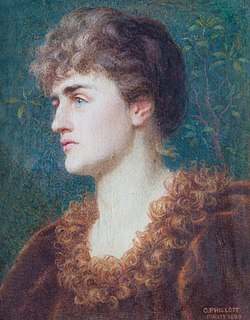
Eugénie Sellers Strong was a British archaeologist and art historian. She was Assistant Director of the British School at Rome from 1909 to 1925. After studying at Girton College, Cambridge, in 1890 she became the first female student admitted to the British School at Athens; she continued art historical studies in Germany under Adolf Furtwängler. In 1897 she married art historian Sandford Arthur Strong. She contributed to the catalogue of the 1903 Burlington Fine Arts Club "Greek Art" Exhibition, and wrote several books on classical art and sculpture.

Lucy May Stanton was an American painter. She made landscapes, still lifes, and portraits, but Stanton is best known for the portrait miniatures she painted. Her works are in the National Portrait Gallery in Washington, D.C., Metropolitan Museum of Art in New York, the Museum of Fine Arts in Boston, and the Philadelphia Museum of Art, where Self-Portrait in the Garden (1928) and Miss Jule (1926) are part of the museum's permanent collection.
Evelyn Byrd Harrison was an American classical scholar and archaeologist. She was Edith Kitzmiller Professor of the History of Fine Arts at the Institute of Fine Arts of New York University and was for more than 60 years associated with the American School of Classical Studies at Athens. Harrison specialized in 5th century B.C. Athenian Sculpture.
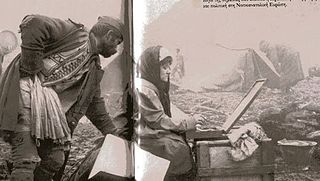
Thalia Flora-Karavia was a Greek artist and member of the Munich School who was best known for her sketches of soldiers at war.

Anna Marguerite McCann was an American art historian and archaeologist. She is known for being an early influencer—and the first American woman—in the field of underwater archaeology, beginning in the 1960s. McCann authored works pertaining to Roman art and Classical archaeology, and taught both art history and archaeology at various universities in the United States. McCann was an active member of the Archaeological Institute of America, and received its Gold Medal Award in 1998. She also published under the name Anna McCann Taggart.